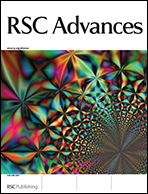Design of hybrid conjugates based on chemical similarity†
Abstract
Conducting polymer–amino acid hybrid materials have been prepared by conjugating poly(3,4-ethylenedioxythiophene) (PEDOT) and an amino acid bearing a 3,4-ethylenedioxythiophene (EDOT) ring as a side group. Two amino acids have been designed, synthesized and characterized. These compounds differ in the presence or not of a methylene group between the EDOT ring and the backbone (i.e.I and II, respectively). The electrochemical properties of PEDOT and their conjugates with I and II (PEDOT-I and PEDOT-II) have been determined using cyclic voltammetry and electrochemical impedance spectroscopy, and subsequently compared. Incorporation of end capping amino acids has been found to increase the hydrophilicity of PEDOT surface, which is consistent with the better behaviour of the conjugates as the cellular matrix. The electronic properties of both the amino acids and the conjugates have been investigated by UV-vis spectroscopy. Results indicate that elimination of the methylene group of I provokes a reduction of 0.13 eV in the π–π* lowest transition energy (Eg) of the conjugate. This decrease is explained by the larger structural flexibility due to the methylene group in I. Calculations of the electronic properties of the two hybrids at the molecular level using quantum mechanical methods suggest that the end capping amino acids essentially affect the electronic intermolecular effects.


 Please wait while we load your content...
Please wait while we load your content...